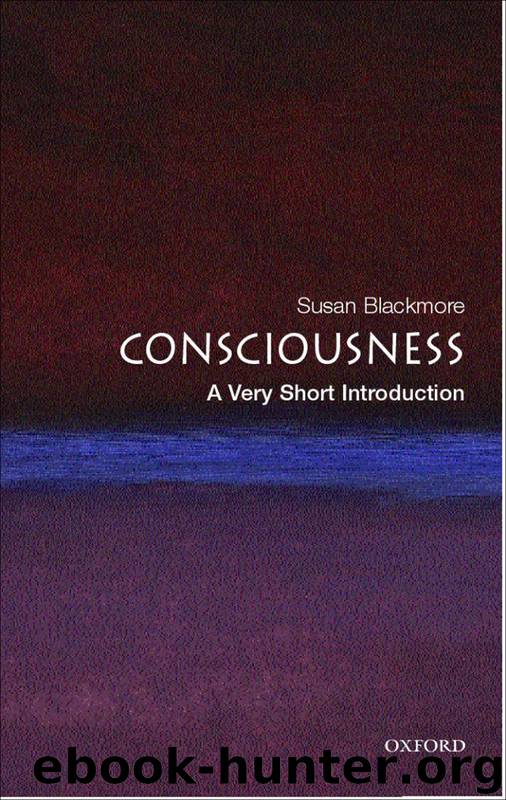Consciousness by Blackmore Susan;

Author:Blackmore, Susan; [Blackmore, Susan;]
Language: eng
Format: epub
ISBN: 9780192805850
Publisher: Oxford University Press, UK
Published: 2005-01-15T07:00:00+00:00
16. Cross-wiring of the human brain. Split-brain patient P. S. was shown a snow scene to the left and a chicken claw to the right. So the speaking left hemisphere could see only the chicken claw.
In a typical experiment the patient sat in front of a screen that was divided into two, and looked steadily at the centre. Words or pictures were then flashed to one side or the other, thus sending information to only one hemisphere. The patient could respond verbally, or by using either hand.
Suppose that a picture was flashed to the right visual field. Since speech in most people is restricted to the left hemisphere, the patient could then describe it, quite normally, but if it was flashed on the left side, he could not. This showed that the left hemisphere, with its ability to speak, could only see what was shown on the right. Meanwhile, the right hemisphere could see what was on the left. This was revealed by asking patients to respond without words. For example, they could be given a pile of objects hidden in a bag and asked to select which had been seen using the left hand. In this way, the two hemispheres could simultaneously give different answers to the question ‘what can you see?’. And neither seemed to know what the other was doing. Does this make them two conscious people?
In a famous experiment, the split-brain patient P. S. was shown a snow scene to the left and a chicken claw to the right and asked to pick out matching pictures from an array in front of him. With his left hand he chose a shovel (for the snow), and with his right hand a chicken. This makes sense in terms of what each half saw, but when asked to explain his reasons, he (i.e. the speaking left brain) said ‘Oh, that’s simple. The chicken claw goes with the chicken, and you need a shovel to clean out the chicken shed.’
In this way, the verbal left brain covered up its ignorance by confabulating. It did the same when the other half was shown an emotional picture – making up a plausible excuse for laughing, smiling, blushing, or whatever emotional reaction had been provoked. This might help to explain how these patients can appear so normal. But it should also make us wonder about ourselves. Our brains consist of lots of relatively independent modules, and the verbal part does not have access to everything that goes on, yet it frequently supplies convincing reasons for our actions. How many of these are plausible confabulations rather than true reasons, and can we tell?
From these experiments, Sperry concluded that his patients had two conscious entities in one head; each having private sensations and free will. In contrast, Gazzaniga argued that only the left hemisphere sustains ‘the interpreter’, which uses language, organizes beliefs, and ascribes actions and intentions to people. Only this hemisphere has ‘high-level consciousness’, leaving the other hemisphere with many abilities and skills but without true consciousness.
Download
This site does not store any files on its server. We only index and link to content provided by other sites. Please contact the content providers to delete copyright contents if any and email us, we'll remove relevant links or contents immediately.
When Breath Becomes Air by Paul Kalanithi(7276)
Why We Sleep: Unlocking the Power of Sleep and Dreams by Matthew Walker(5665)
Paper Towns by Green John(4179)
The Immortal Life of Henrietta Lacks by Rebecca Skloot(3834)
The Sports Rules Book by Human Kinetics(3598)
Dynamic Alignment Through Imagery by Eric Franklin(3503)
ACSM's Complete Guide to Fitness & Health by ACSM(3475)
Kaplan MCAT Organic Chemistry Review: Created for MCAT 2015 (Kaplan Test Prep) by Kaplan(3430)
Introduction to Kinesiology by Shirl J. Hoffman(3308)
Livewired by David Eagleman(3137)
The River of Consciousness by Oliver Sacks(2999)
Alchemy and Alchemists by C. J. S. Thompson(2918)
The Death of the Heart by Elizabeth Bowen(2910)
Descartes' Error by Antonio Damasio(2746)
Bad Pharma by Ben Goldacre(2738)
The Gene: An Intimate History by Siddhartha Mukherjee(2502)
Kaplan MCAT Behavioral Sciences Review: Created for MCAT 2015 (Kaplan Test Prep) by Kaplan(2495)
The Fate of Rome: Climate, Disease, and the End of an Empire (The Princeton History of the Ancient World) by Kyle Harper(2444)
The Emperor of All Maladies: A Biography of Cancer by Siddhartha Mukherjee(2440)
